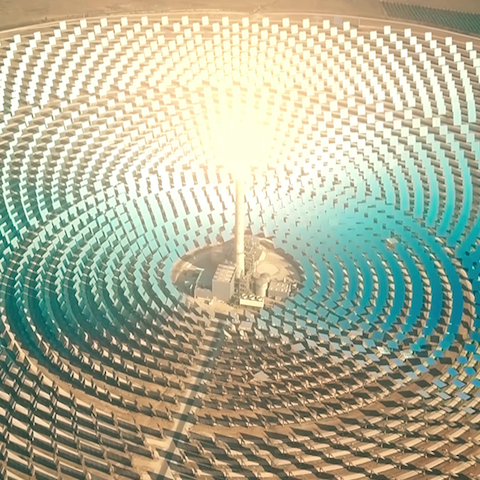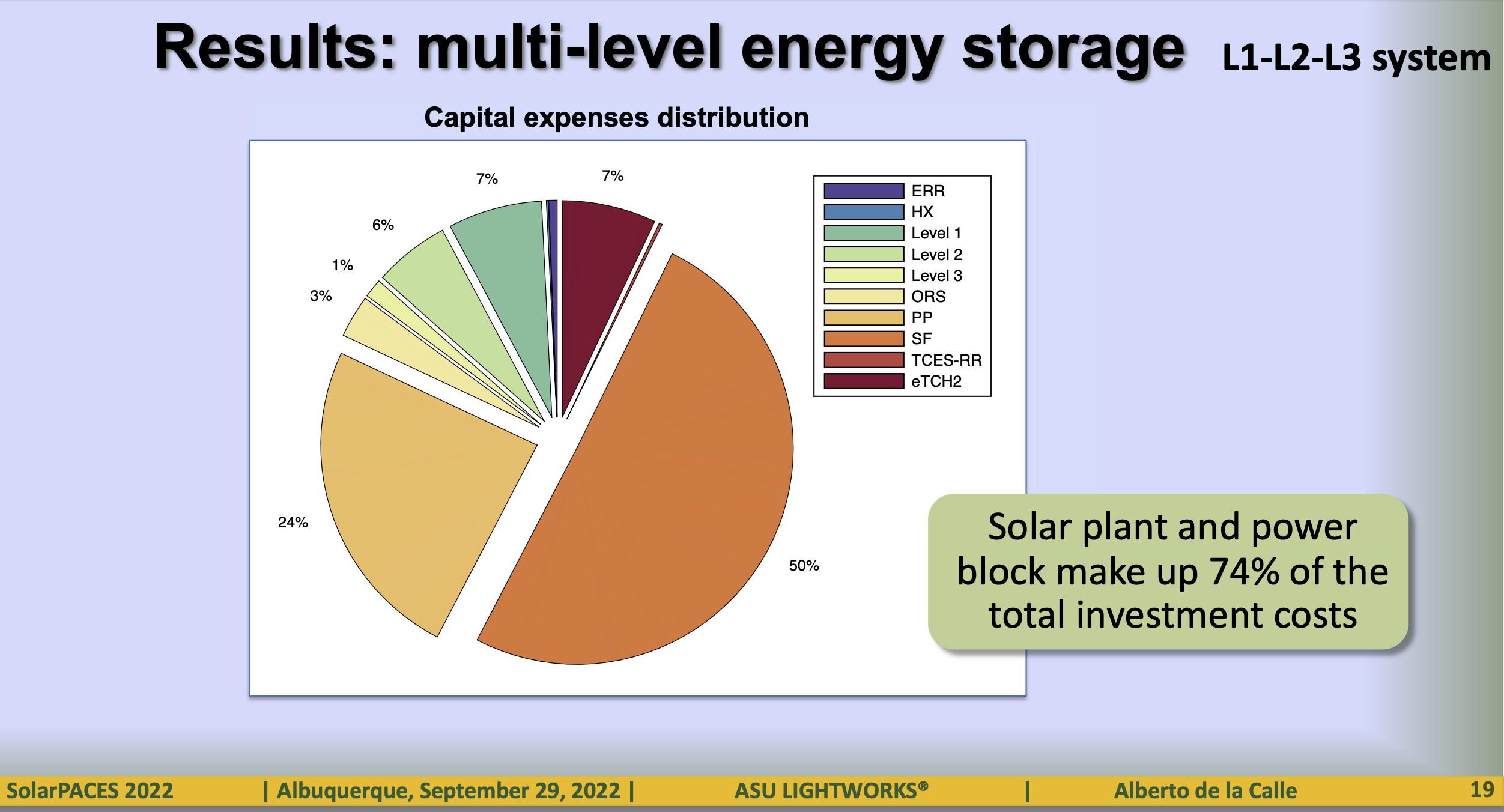Gen3 Solar Delayed By Thermal Storage For Months

365 Days Of Solar Power, Even On Cloudy Days
The Gen3 CSP plant cost a lot. But, when they added thermochemical storage and a hydrogen production reactor, the cost didn't go up much. It did, however, make storage better.

Simple things are usually less expensive. But the developers of a thermochemical energy storage system for Gen3 CSP believe their complicated system will lower costs. It can deliver solar energy for weeks or months, unlike current systems that only last for a day or two.
Sandia is building an advanced CSP pilot plant. They won the US Department of Energy Gen3 CSP award. This plant will have a dual thermochemical energy storage system. It will be tested at Sandia's heliostat testing center in New Mexico.
Sandia has a new project called Gen3. It has a free-falling particle receiver and high-temperature particle storage. The particles are like sand and make supercritical-CO2 really hot. Supercritical-CO2 is very efficient and is used in a Brayton cycle loop.
Commercial CSP stores solar energy in molten salt to deliver after dark. However, Sandia's Gen3 pilot uses particles that remain stable at higher temperatures. This method is more efficient than molten salt. The thermal storage supplies solar energy for 8 to 10 hours.
ASU did a study on solar energy. Professor Ellen Stechel led the study. They found a way to lower the cost of solar energy. Adding thermochemical redox cycles can help. This energy can be used whenever it is needed, even months later.
ASU assistant research scientist Alberto de la Calle explained that their system offers three levels of storage to ensure dispatchability throughout the year. This is the novelty of their system.
At the SolarPACES Conference, De la Calle presented a new idea. The idea involves a concentrated solar power plant. It would use a multi-level storage system. This would guarantee the plant's dispatchability all year long. There was also an analysis done. It was a Techno-economic Analysis.
Store Thermal Energy To Shift Solar Energy For Longer Periods
We want to add two extra energy storage levels. One releases energy after a week, and the other delivers it any time, even in a few months. Each technology uses different ways to store and give energy. Instead of using only one heat input, we have more ways to charge.
The researchers have a special way of charging weekly and yearly thermal energy storage. Daily electricity would come from stored heat, like commercial CSP.
There are two new systems. They work together. They have thermochemical cycles. One stores heat. The other makes hydrogen.
Sandia Gen3 CSP uses Level 1 storage to store sensible heat. Hot particles are heated in the thermal energy tank by solar heliostats. The heat is used to run an s-CO2 turbine to produce electricity. The particle tank stores one day's supply.
If you need storage every week, you could add storage with heat. This would happen by using a cycle of heating (charging) and cooling (discharging) a metal oxide. This process makes heat that you can use.

The project has a goal to find the best metal oxide. They are testing CaAl0.2Mn0.8O3, a perovskite already used in these cycles. This was said by de la Calle.
The Zigzag Flow Reactor has three ways to charge it. First, heat from storage tank with off-peak electricity. Second, using only off-peak electricity when it's cheap. Third, chemical reduction with hydrogen made on-site.
The storage is made of particles. They react when heated to 1000°C without oxygen. Oxygen is released from the lattice. The particles are put in a tank to store them. When it's time to use the storage, the particles are mixed with oxygen. This causes a second reaction that releases heat. The storage size is similar to Gen3's, but the energy density is higher and can last for about a week.
A special heat exchanger has been designed. It helps recover heat stored in the reduced metal oxide. The exchanger converts particles to s-CO2. This is where the re-oxidation reaction takes place.
To store stuff during seasons (Level 3), include a hydrogen reactor. Hydrogen will be made on the spot using the Labyrinth Reactor at ASU. This reactor uses a new design that splits water and carbon dioxide at the SolarPACES Conference. It can run on off-peak grid electricity.
De la Calle said the reduction reaction is at 1500°C in this reactor. The re-oxidation reaction is at about 1000°C with ceria as the metal oxide.
Level 3 storage uses steam for re-oxidation instead of Level 2. When reduced metal oxide is mixed with water, it releases hydrogen by taking oxygen from water.
Hydrogen is made in a reactor and kept in a container. It's used for a reduction reaction in Level 2 and sent to the grid using s-CO2. People can also sell this Hydrogen to the grid.
The metal oxide used in redox reaction has a maximum chemical potential. This happens because of the counter-current configuration of the two thermochemical reactions.
Complex System Can Reduce LCOE
The team proved that their system can make 8 hours of solar energy every day, every season. It works even if there's not a lot of sunlight on a day.
This system lets us buy and sell electricity when it suits us. We can sell hydrogen too, to offset costs. The hydrogen revenue is enough to pay for capital expenses.
The Gen3 CSP plant cost more than adding thermochemical storage and a hydrogen production reactor. Adding those elements added more value by making the storage last longer.
Adding thermochemical storage and a hydrogen production reactor to the Gen3 CSP plant didn't cost a lot. However, it increased the value of the plant by extending storage duration.
We checked if our storage system was good by comparing it to a regular one. We used the LCOE of a CSP plant with daily storage as the comparison. We changed the solar multiples and storage capacities. Our system was better! We make the LCOE lower and can use it anytime during the year. Our system is 16% less expensive than the baseline.
Adding two thermochemical storage systems (Level 1 and 2) didn't cost much extra. It made a big difference in the amount of weekly and seasonal storage. This is what lowered the LCOE.
Want to read more? Check out "Development and testing of the Zigzag Flow Reactor for thermochemical energy storage" by Rhushikesh Ghotkar at the SolarPACES Conference 2022.
A device called the Labyrinth Thermochemical Reactor was created and tested at ASU. It splits water and CO2. Ivan Ermanoski presented this at the SolarPACES Conference in 2022.
The study looks at different designs for a heat exchanger. The heat exchanger is for a high temperature particle-to-sCO2 system. The goal is to find the best design. The researchers studied four designs. Each design had its own strengths and weaknesses. The researchers evaluated the designs using different factors. They looked at factors such as pressure drop, effectiveness, and efficiency. They found that each design had different trade-offs. Overall, the researchers suggested that a double-walled design may be the best option.
The conference titled "s-CO2 Europe" discussed the thermodynamic analysis of a reactive particle-to-sCO2 heat exchanger. This technology can recover stored thermochemical energy. The conference was held in 2023.
Solar researchers have found a way to decrease variability in hydrogen production. Hydrogen production using solar energy can be complicated due to fluctuations in sunlight availability and temperature changes. However, scientists have found that by storing and releasing heat, they can stabilize the process. This new method can lead to a more consistent and reliable hydrogen production process. Hydrogen has potential as a renewable energy source, so this development is exciting for the future of clean energy.

